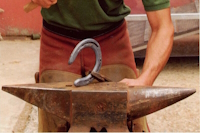Blacksmith
The blacksmith is the craftsman who mainly practices the art of shoeing. It consists in the application of metal parts, called shoes, to the horses' hooves to protect them from wear and tear and maintain their natural balance.
From the English mare - mare - and shall - duty, responsibility - the mariscalco (now farrier) did not have the sole task of shoeing the horse but, until a few years ago, he took care of it entirely and personally made the shoes according to the characteristics and needs of each horse.
Today industrial production makes the artisanal creation of irons useless. However, it remains necessary for the farrier to know and be able to work the iron hot or cold to be able to adapt the rods and metal plates to the horses' hooves.
The blacksmith's work requires considerable physical effort; in fact, it takes place by standing for hours bent over the horses' legs, supporting their weight. But above all he must have sensitivity and quick reflexes. He must recognize the moods of the horses. understand their intentions and therefore predict sudden outbursts.
To the necessary manual skill, the farrier must also combine knowledge of the anatomy of the limbs and in particular of its extremities, and know the gaits and perpendicularity of the horse. It is up to him to create shoeing that takes into account the individual conformation of the animal, also paying attention to the choice of shoe, which must be made according to the use of the horse.
His intervention is fundamental not only when it comes to shoeing normal feet but also and above all to correct diseased feet and faulty gaits, restoring the balance of the hoof. Despite the spread of the practice of "barefoot riding", shoeing continues to be necessary for many types of sports in which horses, and therefore their hooves, are subjected to unnatural rhythms. Indeed, this trend has given new impetus to the development of modern and more natural techniques for trimming the hoof and recovering unshod horses.
Thanks to the use of new materials, such as glueable irons and laceable shoes to be used in particular situations, farriery is increasingly revealed as an art in step with the evolution of veterinary science and modern technological discoveries.
